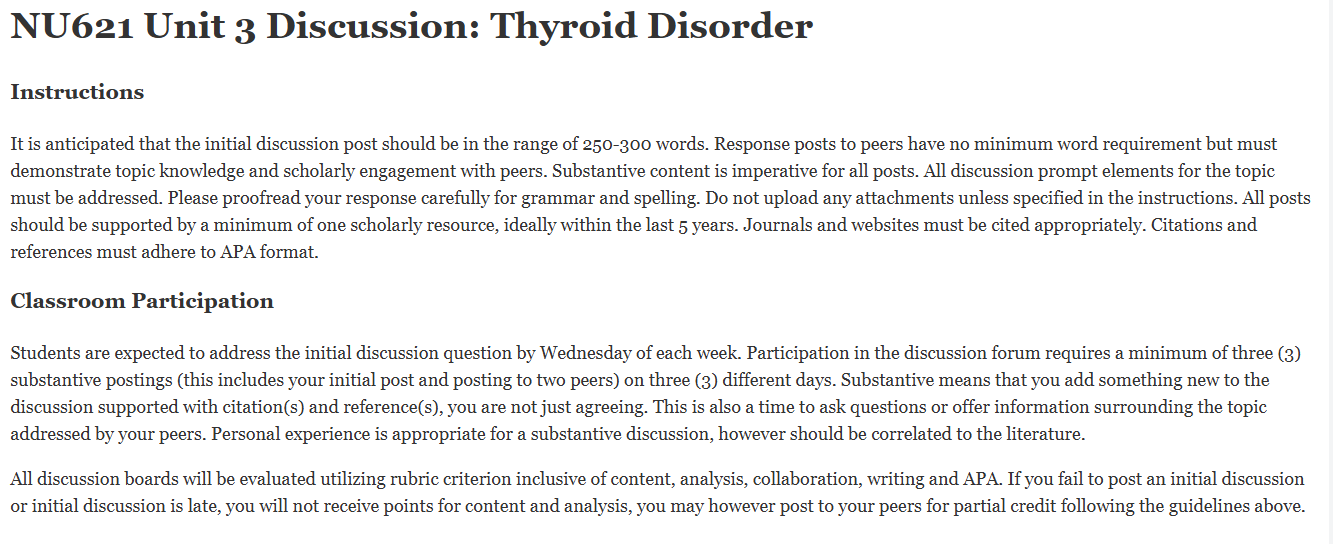NU621 Unit 3 Discussion: Thyroid Disorder
Instructions
It is anticipated that the initial discussion post should be in the range of 250-300 words. Response posts to peers have no minimum word requirement but must demonstrate topic knowledge and scholarly engagement with peers. Substantive content is imperative for all posts. All discussion prompt elements for the topic must be addressed. Please proofread your response carefully for grammar and spelling. Do not upload any attachments unless specified in the instructions. All posts should be supported by a minimum of one scholarly resource, ideally within the last 5 years. Journals and websites must be cited appropriately. Citations and references must adhere to APA format.
Classroom Participation
Students are expected to address the initial discussion question by Wednesday of each week. Participation in the discussion forum requires a minimum of three (3) substantive postings (this includes your initial post and posting to two peers) on three (3) different days. Substantive means that you add something new to the discussion supported with citation(s) and reference(s), you are not just agreeing. This is also a time to ask questions or offer information surrounding the topic addressed by your peers. Personal experience is appropriate for a substantive discussion, however should be correlated to the literature.
All discussion boards will be evaluated utilizing rubric criterion inclusive of content, analysis, collaboration, writing and APA. If you fail to post an initial discussion or initial discussion is late, you will not receive points for content and analysis, you may however post to your peers for partial credit following the guidelines above.
Initial Response
Instructions:
Thyroid disorders, such as hypothyroidism and hyperthyroidism, are common endocrine conditions that can significantly affect multiple body systems. Understanding the underlying pathophysiology is critical for diagnosing and managing these conditions effectively.
For this week’s discussion:
- Choose a thyroid disorder (e.g., hypothyroidism, hyperthyroidism, Hashimoto’s thyroiditis, or Graves’ disease) and explain the key aspects of its pathophysiology.
- What are the primary mechanisms that lead to the disorder?
- How does the dysfunction in thyroid hormone production or regulation affect the body at the cellular level?
- How do laboratory values (e.g., TSH, free T4, and free T3) correlate with the pathophysiological changes?
- Provide an example of a clinical presentation of a patient with this thyroid disorder. How do the pathophysiological changes you described relate to the symptoms and physical findings in the patient?
Please be sure to validate your opinions and ideas with citations and references in APA format.
Please review the rubric to ensure that your response meets the criteria.
Your initial response is due by Wednesday at 11:59 pm CT.
Estimated time to complete: 2 hours
Peer Response
Instructions:
To ensure that your responses are substantive, consider one of the following prompts in your peer replies:
- Reflect on the thyroid disorder chosen by your peer, do you agree with their discussion of the pathophysiology? What information could you add to their discussion?
- Create an example of a clinical presentation that reflects the opposite diagnosis of what was chosen by your peer. (For example, your peer described a clinical presentation of Hashimoto’s thyroiditis. You would describe a clinical presentation of Graves’ disease.) Compare and contrast the physical findings.
Responses need to address all components of the question, demonstrate critical thinking and analysis, and include peer reviewed journal evidence to support the student’s position.
Please be sure to validate your opinions and ideas with citations and references in APA format.
Please review the rubric to ensure that your response meets the criteria.
All peer responses are due by Sunday at 11:59 pm CT.
Estimated time to complete: 1 hour
SOLUTION NU621 Unit 3 Discussion: Thyroid Disorder
1. Choose a thyroid disorder (e.g., hypothyroidism, hyperthyroidism, Hashimoto’s thyroiditis, or Graves’ disease) and explain the key aspects of its pathophysiology.
Hypothyroidism is caused by a decrease in TH and an increase in TSH and TRH and this is due to autoimmune thyroiditis, iatrogenic loss of thyroid tissue after surgical or radiation treatment, medication, and endemic iodine deficiency. Infants and children may present with hypothyroidism because of congenital deficiency and secondary cause by the pituitary failure to make enough TSH and not enough TRH. Pituitary tumors that press the surrounding cells….
Kindly click the purchase icon below to buy the full solution at $5
(FINAL ANSWER) NU621 Unit 3 Assignment – Polycystic Ovarian Syndrome

